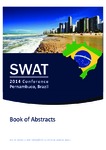Please use this identifier to cite or link to this item:
http://www.alice.cnptia.embrapa.br/alice/handle/doc/1002742| Title: | The influence of different land cover and land use on hydrological response of Barro Branco Watershed, Rio de Janeiro, Brazil. |
| Authors: | BRAZÃO, C.  FERNANDES, N.   BHERING, S.   |
| Affiliation: | CHRISTIANE BRAZÃO, UFRJ; NELSON FERNANDES, UFRJ; SILVIO BARGE BHERING, CNPS. |
| Date Issued: | 2014 |
| Citation: | In: INTERNATIONAL SWAT CONFERENCE, 2014, Porto de Galinhas. Book of abstracts. [S.l.: s.n.], 2014. p. 98-99. |
| Description: | The physical and biotic characteristics of a watershed have fundamental importance in the hydrological cycle processes, influencing the infiltration, the runoff, evapotranspiration and surface and subsurface flows. The soil erosion is directly influenced by surface hydrological processes and land management practices, through the sediment production, transport and deposition. In this work the spatial distribution of flow was analyzed in the Barro Branco watershed by SWAT (Soil and Water Assesment Tools) model. This watershed, with 6km2 is inserted in the Northwest Region of Rio de Janeiro State, Brazil. The KOPPEN (1948) climatic classification is Aw, tropical climate with dry winters. The predominant soils are Gley soils and Ultisols. The land use and land cover are divided into: grazing, altered natural vegetation and bare soil. The hydrological processes modeling at catchment scale is an important tool for streamflow simulation. In order to carry out the simulations, the model employs a spatial databank of basin, made up of geographical, pedological, hydrological and climate data, as output data the model generates tables and maps. It was observed that, before calibration, the minimum flows estimated were below those observed, but the peak flows were overestimated. After calibration, the minimum flows had better correlations, while the peak flows were underestimated. The simulation results were compared to streamflow experimentally data observed in 2008. The Nash-Suctlife Efficiency Coefficient (NS), factor regression (R²) and PBIAS was adopted in order to validate the model prediction. The main statistical indices showed significant improvement after calibration and remained satisfactory after validation. Being the NS after calibration of 0.7 and 0.5 after validation; R² Coefficient obtained after calibration was 0.5 and after validation 0.7, finally, the PBIAS calibrated was 12.7 and validated, 13.02. The model was sensitive to the parameters for the soils, first the entire amount of capacity of available soil water to the basin was converted in runoff. However, once the parameters that conditioned infiltration were calibrated, the simulated flow approached significantly to observed data. The SWAT model was able to simulate streamflow in Barro Branco watershed, since there were not many gaps in the monitored data, and also being able to simulate data from other periods for which the parameters were not adjusted. |
| Thesagro: | Bacia hidrográfica Conservação da água Conservação do solo |
| NAL Thesaurus: | Watersheds Hydrologic models Water conservation Soil conservation |
| Keywords: | Modelação hidrológica Conservação de água e solo SWAT |
| Type of Material: | Resumo em anais e proceedings |
| Access: | openAccess |
| Appears in Collections: | Resumo em anais de congresso (CNPS)  |
Files in This Item:
| File | Description | Size | Format | |
|---|---|---|---|---|
| SWATBhering3.pdf | 481.8 kB | Adobe PDF |  View/Open |









